Enhancing Photoluminescence Intensity and Spectral Bandwidth of Hybrid Nanofiber/Thin-Film Multilayer Tm3+-Doped SiO2–HfO2
Abstract
1. Introduction
2. Materials and Methods
2.1. Solution Preparation
2.2. Deposition of Nanofiber/Thin-Film Multilayer Structure
2.3. Sample Characterization
2.4. Theoretical Aspects
3. Results and Discussion
3.1. Comparing Thin-Film and Nanofiber Results
3.2. Morphological and Structural Properties of Multilayer Structures
3.3. Optical Properties of Multilayer Structures
3.4. Comparison of Experimental and Theoretical Results
4. Conclusions
Author Contributions
Funding
Data Availability Statement
Acknowledgments
Conflicts of Interest
References
- Rao, M.; Shekhawat, M. A brief Survey on Basic Properties of Thin Films for Device Application. Int. J. Mod. Phys. Conf. Ser. 2013, 22, 576–582. [Google Scholar] [CrossRef]
- Richter, F.; Kupfer, H.; Schlott, P.; Gessner, T.; Kaufmann, C. Optical properties and mechanical stress in SiO2/Nb2O5 multilayers. Thin Solid Film. 2001, 389, 278–283. [Google Scholar] [CrossRef]
- Sullivan, B.T.; Dobrowolski, J. Deposition error compensation for optical multilayer coatings. I. Theoretical description. Appl. Opt. 1992, 31, 3821–3835. [Google Scholar] [CrossRef]
- Sullivan, B.T.; Dobrowolski, J. Deposition error compensation for optical multilayer coatings. II. Experimental results—Sputtering system. Appl. Opt. 1993, 32, 2351–2360. [Google Scholar] [CrossRef]
- Rahmani, F.; Ardyanian, M. Fabrication and characterization of ZnO/TiO2 multilayers, deposited via spin coating method. J. Mater. Sci. Mater. Electron. 2018, 29, 4285–4293. [Google Scholar] [CrossRef]
- Camposeo, A.; Di Benedetto, F.; Stabile, R.; Neves, A.A.; Cingolani, R.; Pisignano, D. Laser emission from electrospun polymer nanofibers. Small 2009, 5, 562–566. [Google Scholar] [CrossRef]
- Chang, C.-C.; Huang, C.-M.; Chang, Y.-H.; Kuo, C. Enhancement of light scattering and photoluminescence in electrospun polymer nanofibers. Opt. Express 2010, 18, A174–A184. [Google Scholar] [CrossRef]
- Xia, H.; Chen, T.; Hu, C.; Xie, K. Recent advances of the polymer micro/nanofiber fluorescence waveguide. Polymers 2018, 10, 1086. [Google Scholar] [CrossRef]
- Kirchain, R.; Kimerling, L. A roadmap for nanophotonics. Nat. Photonics 2007, 1, 303–305. [Google Scholar] [CrossRef]
- Tong, L.; Gattass, R.R.; Ashcom, J.B.; He, S.; Lou, J.; Shen, M.; Maxwell, I.; Mazur, E. Subwavelength-diameter silica wires for low-loss optical wave guiding. Nature 2003, 426, 816–819. [Google Scholar] [CrossRef] [PubMed]
- Lim, C.T. Nanofiber technology: Current status and emerging developments. Prog. Polym. Sci. 2017, 70, 1–17. [Google Scholar]
- Camposeo, A.; Persano, L.; Pisignano, D. Light-Emitting Electrospun Nanofibers for Nanophotonics and Optoelectronics. Macromol. Mater. Eng. 2013, 298, 487–503. [Google Scholar] [CrossRef]
- Milea, C.; Bogatu, C.; Duta, A. The influence of parameters in silica sol-gel process. Bull. Transilv. Univ. Brasov. Eng. Sciences. Ser. I 2011, 4, 59. [Google Scholar]
- Abd-Rahman, M.K.; Razaki, N.I. Effect of nanofiber/thin-film multilayers on the optical properties of thulium-doped silica-alumina. J. Lumin. 2018, 196, 442–448. [Google Scholar] [CrossRef]
- Zhao, J.; Jia, C.; Duan, H.; Sun, Z.; Wang, X.; Xie, E. Structural and photoluminescence properties of europium-doped titania nanofibers prepared by electrospinning method. J. Alloy Compd. 2008, 455, 497–500. [Google Scholar] [CrossRef]
- Lucas, J.; Lucas, P.; Mercier, T.; Rollat, A.; Davenport, W. Rare Earth Doped Lasers and Optical Amplifiers; Marcel Dekker Inc.: New York, NY, USA, 2015; pp. 319–332. [Google Scholar]
- Farias, P.M.; Santos, B.S.; Chaves, C.R.; Figueiredo, R.C.; Ferreira, R.C.; Fontes, A. Hybrid organic/II–VI quantum dots: Highly luminescent nanostructures for bioimaging. In Molecular Probes for Biomedical Applications II; International Society for Optics and Photonics: San Jose, CA, USA, 2008; Volume 6867, p. 68670G. [Google Scholar]
- Qin, C.; Qin, L.; Chen, G.; Lin, T. One-dimensional Eu3+ and Tb3+ doped LaBO3 nanofibers: Fabrication and improved luminescence performances. Mater. Lett. 2013, 106, 436–438. [Google Scholar] [CrossRef]
- Righini, G.C.; Chiappini, A. Glass optical waveguides: A review of fabrication techniques. Opt. Eng. 2014, 53, 071819. [Google Scholar] [CrossRef]
- Windt, D.L. IMD—Software for modeling the optical properties of multilayer films. Comput. Phys. 1998, 12, 360–370. [Google Scholar] [CrossRef]
- Gupta, S.; Pramanick, A.; Kailath, A.; Mishra, T.; Guha, A.; Nayar, S.; Sinha, A. Composition dependent structural modulations in transparent poly(vinyl alcohol) hydrogels. Colloids Surf. B Biointerfaces 2009, 74, 186–190. [Google Scholar] [CrossRef]
- Khomenkova, L.; An, Y.-T.; Labbé, C.; Portier, X.; Gourbilleau, F. Hafnia-based luminescent insulator for phosphor applications. ECS Trans. 2012, 45, 119. [Google Scholar] [CrossRef]
- Neumayer, D.; Cartier, E. Materials characterization of ZrO2–SiO2 and HfO2–SiO2 binary oxides deposited by chemical solution deposition. J. Appl. Phys. 2001, 90, 1801–1808. [Google Scholar] [CrossRef]
- Gonçalves, R.; Carturan, G.; Zampedri, L.; Ferrari, M.; Montagna, M.; Chiasera, A.; Righini, G.; Pelli, S.; Ribeiro, S.; Messaddeq, Y. Sol-gel Er-doped SiO2–HfO2 planar waveguides: A viable system for 1.5 μm application. Appl. Phys. Lett. 2002, 81, 28–30. [Google Scholar] [CrossRef]
- Khomenkov, D.; An, Y.-T.; Portier, X.; Labbe, C.; Gourbilleau, F.; Khomenkova, L. Light-emitting and structural properties of Si-rich HfO2 thin films fabricated by RF magnetron sputtering. MRS Online Proc. Libr. 2013, 1617, 85–91. [Google Scholar] [CrossRef]
- Dirè, S.; Ceccato, R.; Facchin, G.; Carturan, G. Synthesis of Ni metal particles by reaction between bis (cyclooctadiene) nickel (0) and sol–gel SiO2 modified with Si–H groups. J. Mater. Chem. 2001, 11, 678–683. [Google Scholar] [CrossRef]
- Sorarù, G.D.; D’Andrea, G.; Campostrini, R.; Babonneau, F. Characterization of methyl-substituted silica gels with Si–H functionalities. J. Mater. Chem. 1995, 5, 1363–1374. [Google Scholar] [CrossRef]
- Pauthe, M.; Phalippou, J.; Corriu, R.; Leclercq, D.; Vioux, A. Silica xerogels containing a functional group at silicon. J. Non-Cryst. Solids 1989, 113, 21–30. [Google Scholar] [CrossRef]
- Thami, T.; Tauk, L.; Flaud, V. Controlled structure and hydrophilic property of polymethylhydrosiloxane thin films attached on silicon support and modified with phosphorylcholine group. Thin Solid Film 2020, 709, 138196. [Google Scholar] [CrossRef]
- Karakuscu, A. Synthesis and Characterization of Luminescent Nanostructured SiOC Thin Films. Ph.D. Thesis, University of Trento, Trento, Italy, 2010. [Google Scholar]
- Teki, R.; Koratkar, N.; Karabacak, T.; Lu, T.-M. Enhanced photoemission from nanostructured surface topologies. Appl. Phys. Lett. 2006, 89, 193116. [Google Scholar] [CrossRef]
- Sun, C.Q. Size dependence of nanostructures: Impact of bond order deficiency. Prog. Solid State Chem. 2007, 35, 1–159. [Google Scholar] [CrossRef]
- De Azevedo Marques, A.P.; Künzel, R.; Umisedo, N.K.; Latini, R.M.; Yoshimura, E.M.; Okuno, E. Tm3+ doped barium molybdate: A potential long-lasting blue phosphor. J. Alloy Compd. 2018, 735, 707–717. [Google Scholar] [CrossRef]
- Killada, S. Fabrication of Polymer Surfaces with Varying Roughness and Its Effect on Anti-Reflective Properties; Indian Institute of Technology: Hyderabad, India, 2014.
- Liaparinos, P. Influence of surface roughness on the light transmission through the boundaries of luminescent materials in radiation detectors. Opt. Spectrosc. 2021, 129, 1257–1265. [Google Scholar] [CrossRef]
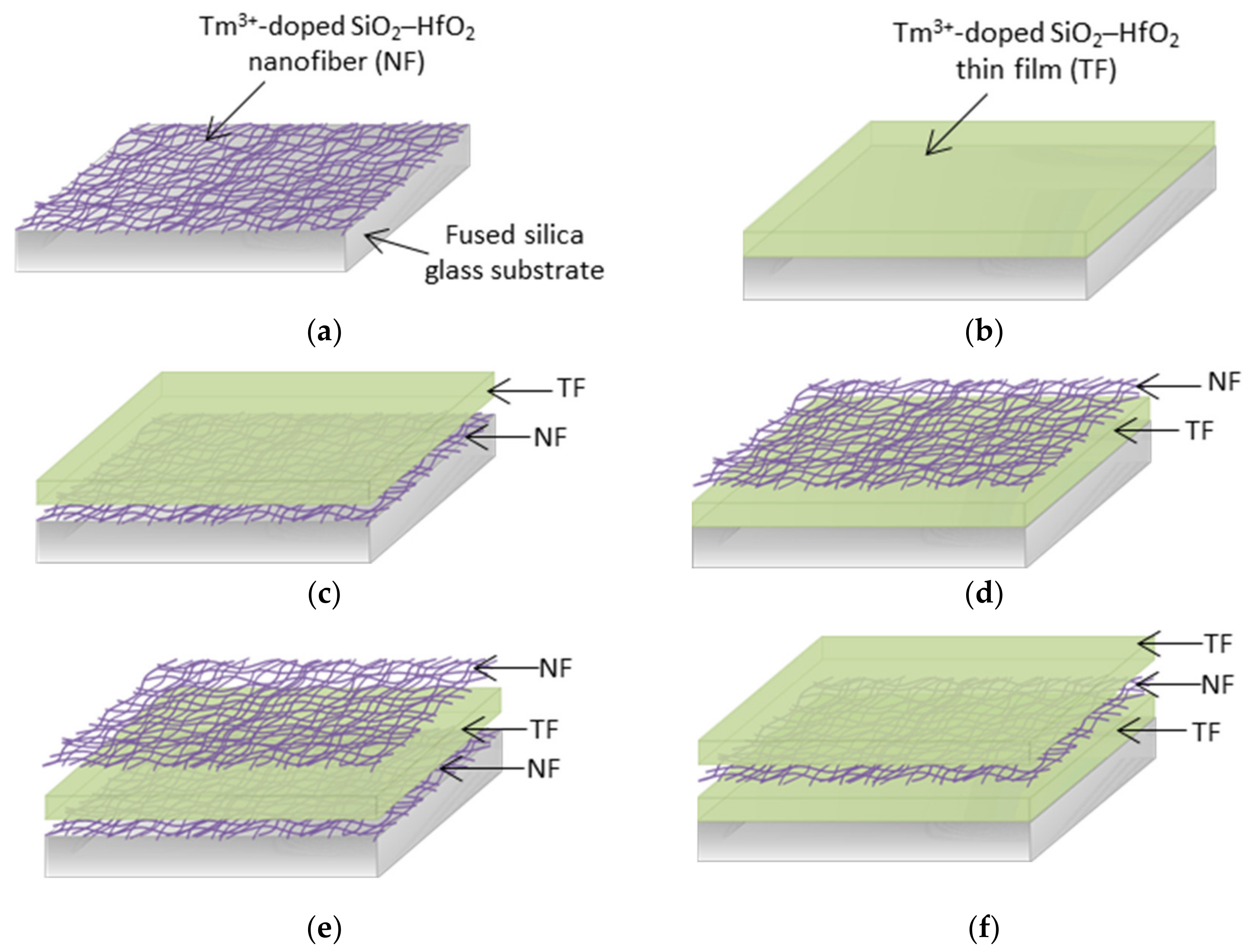

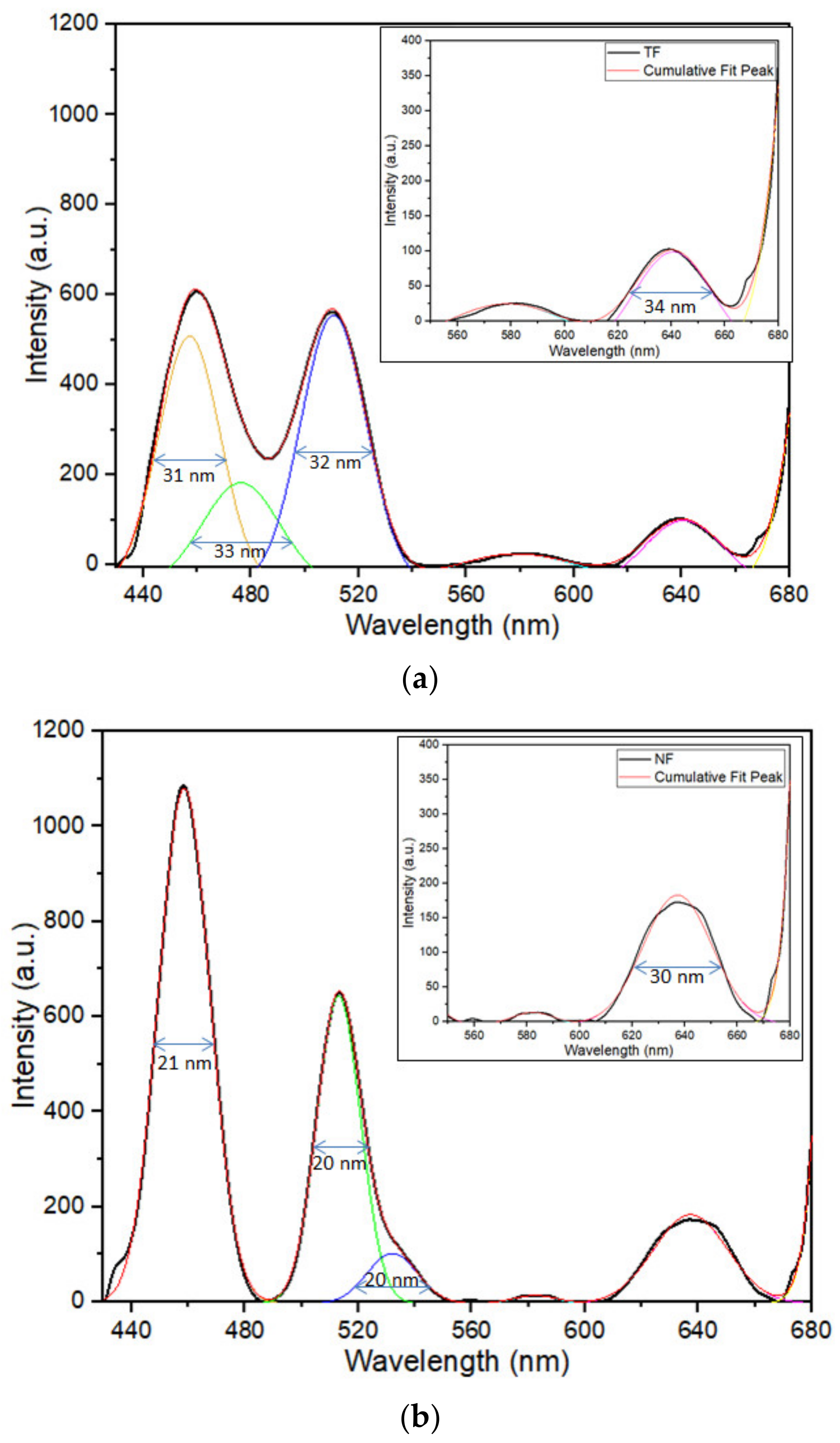
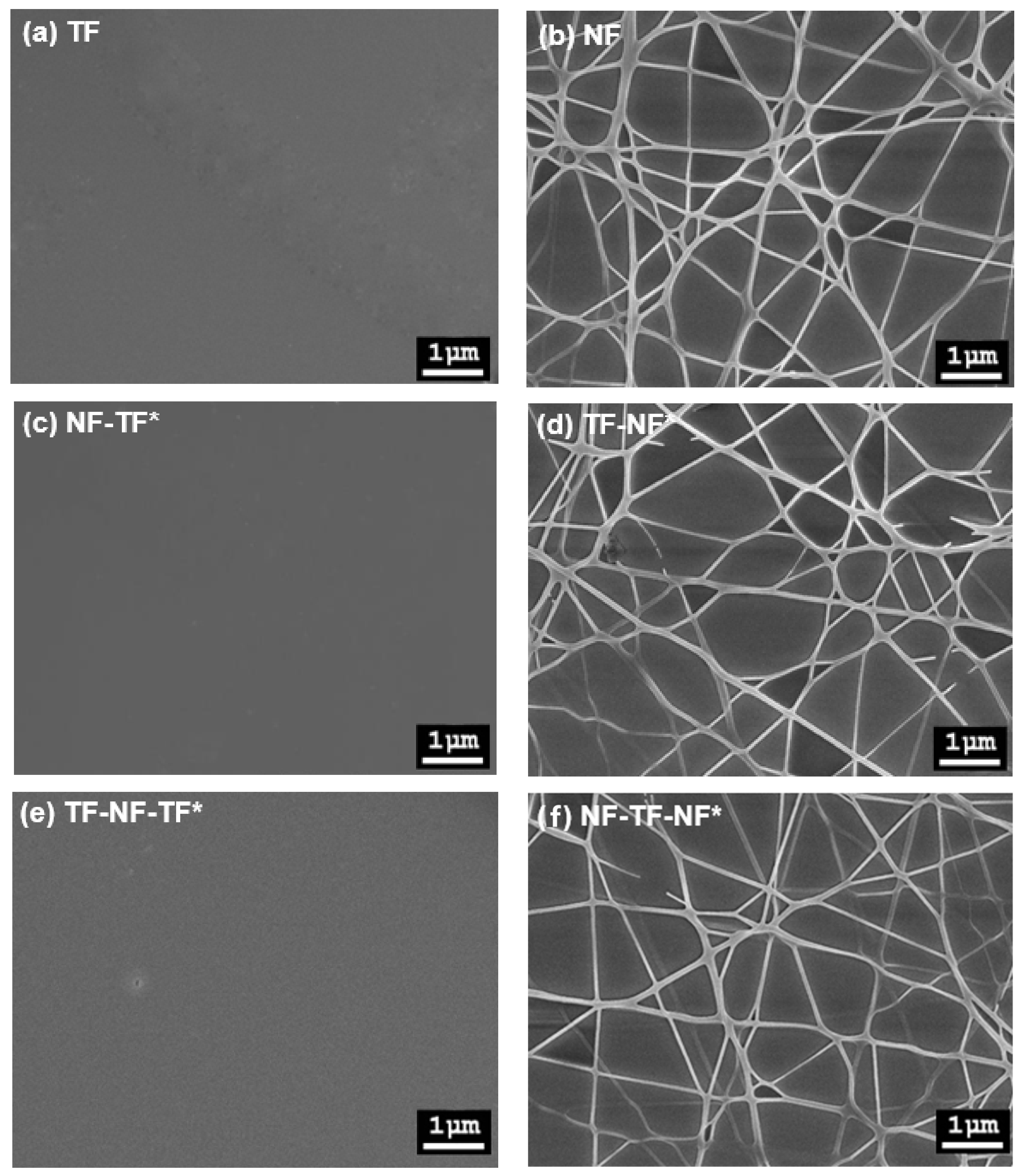

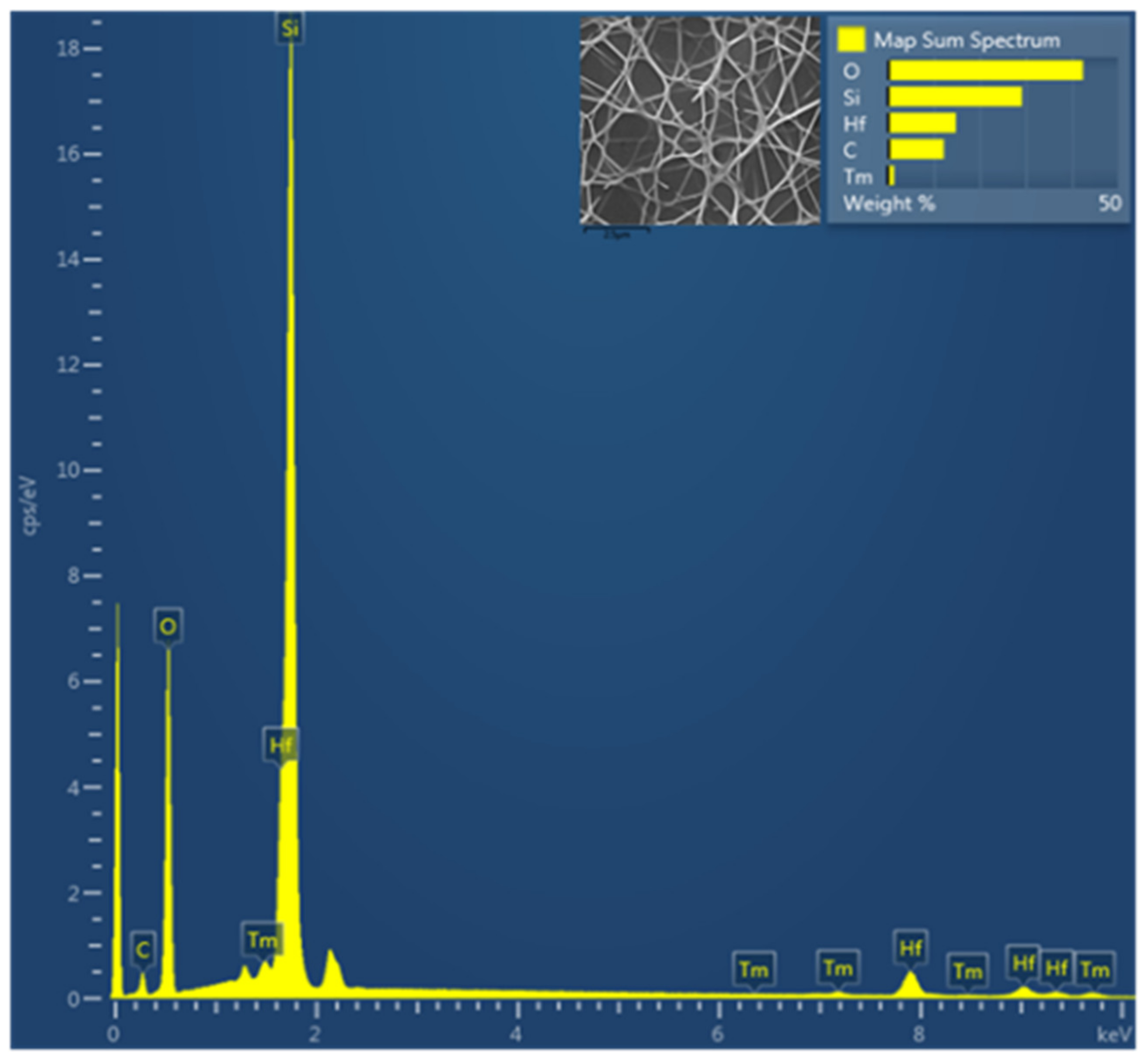
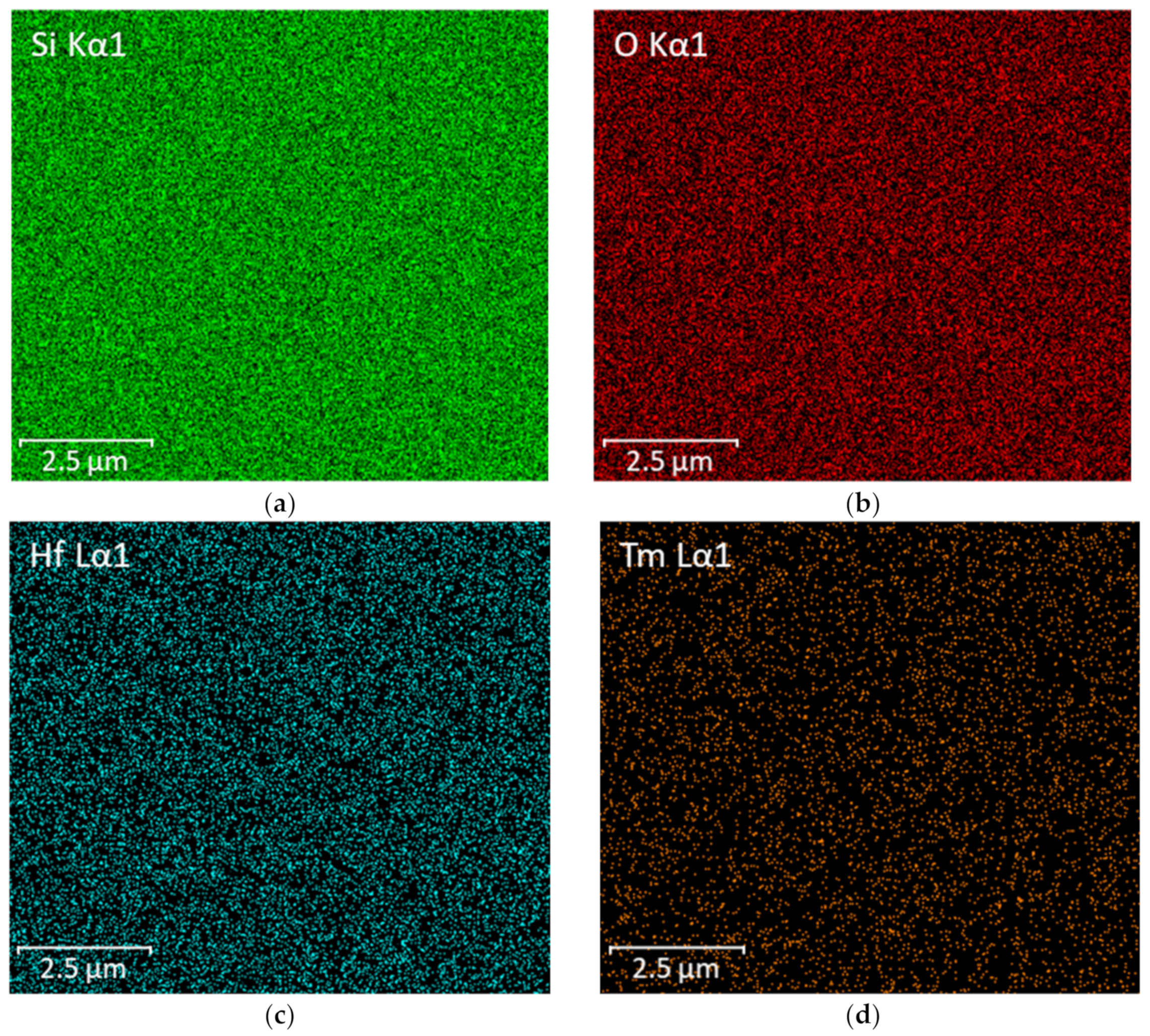
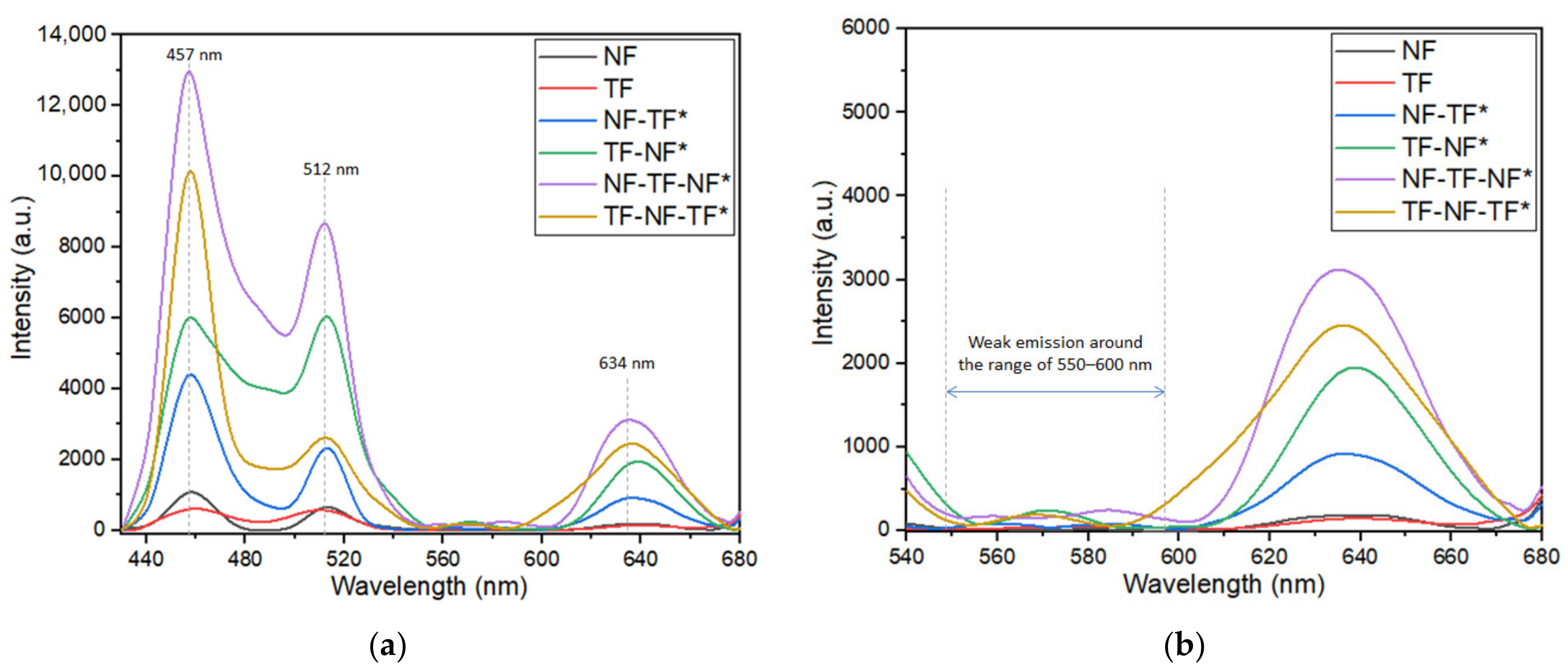

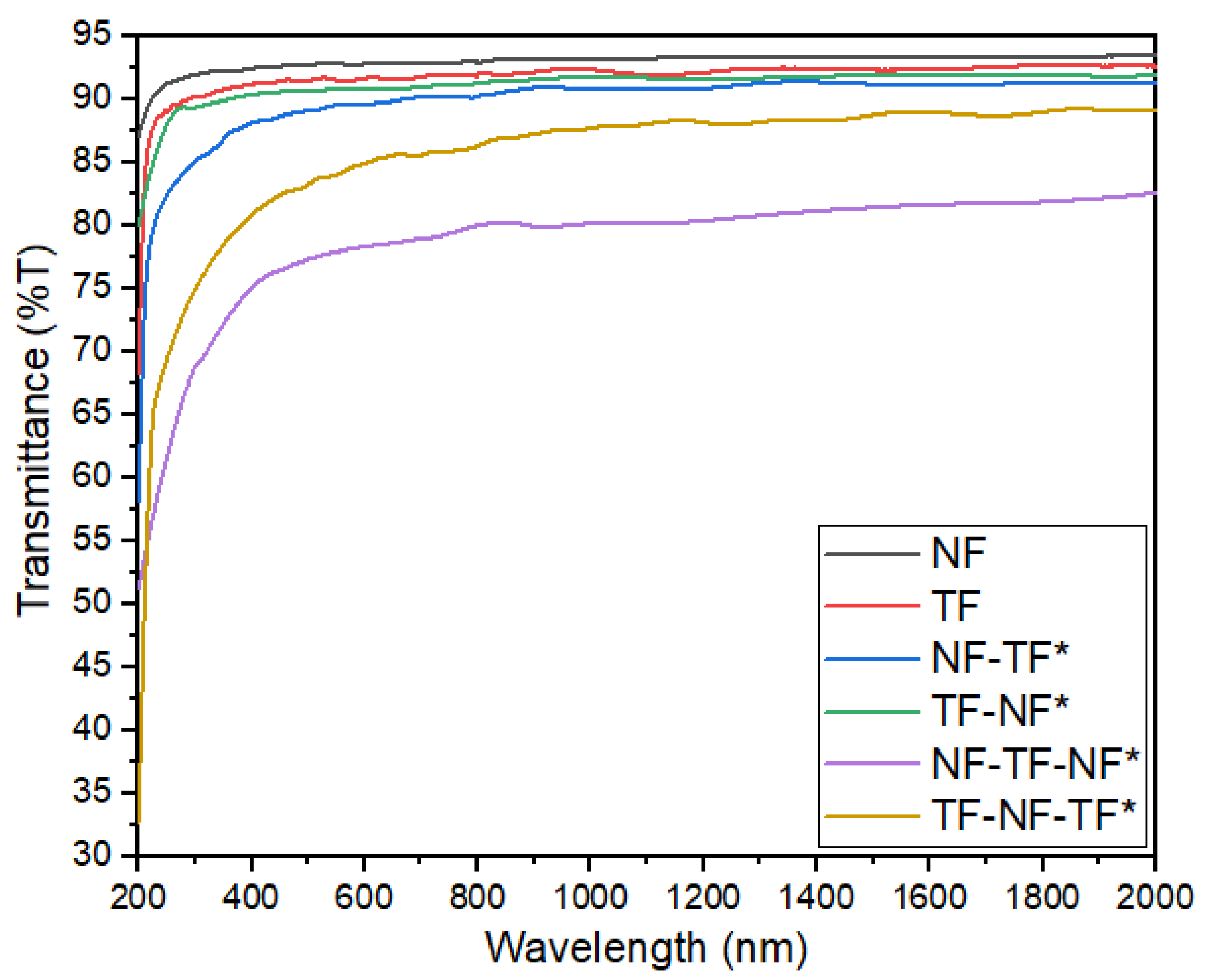
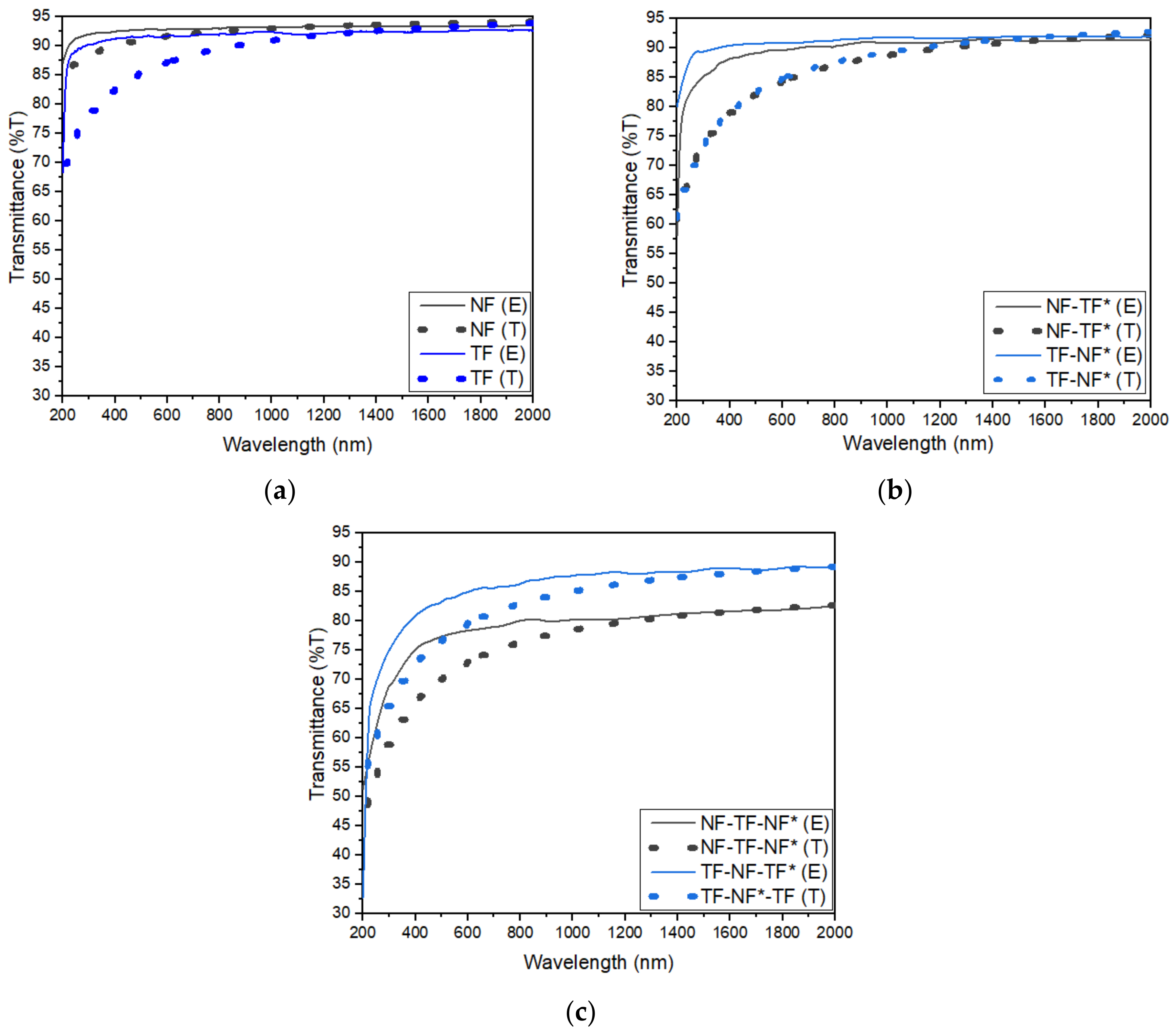
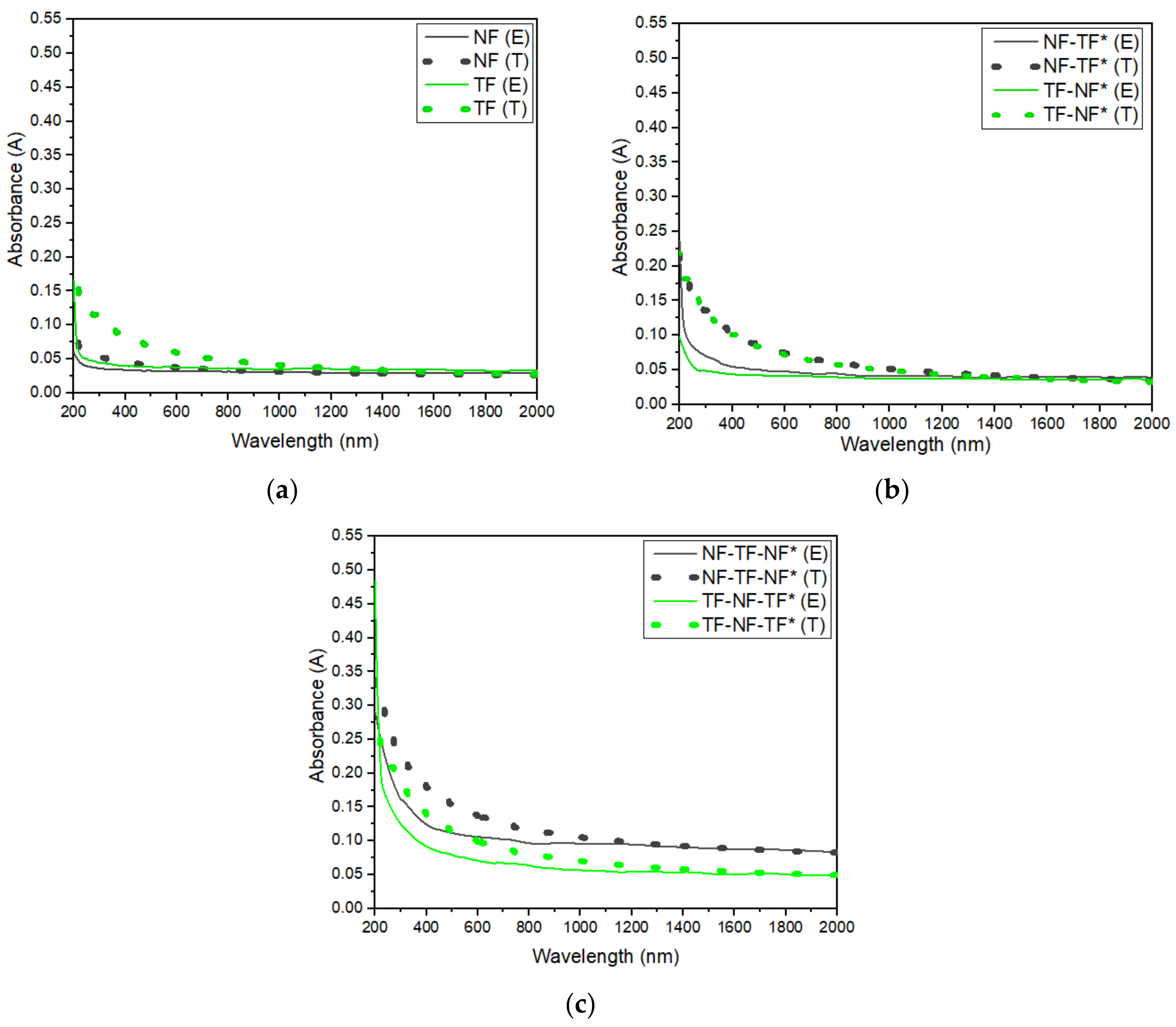
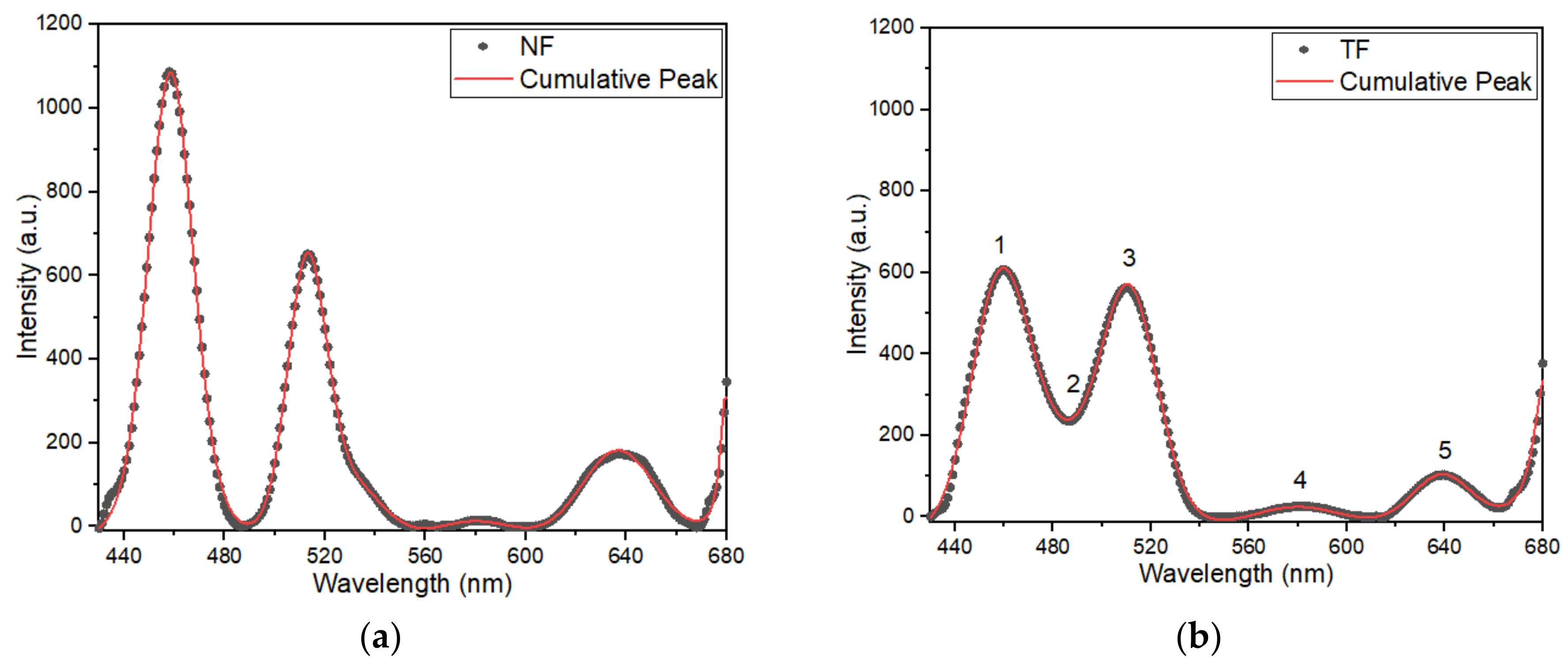
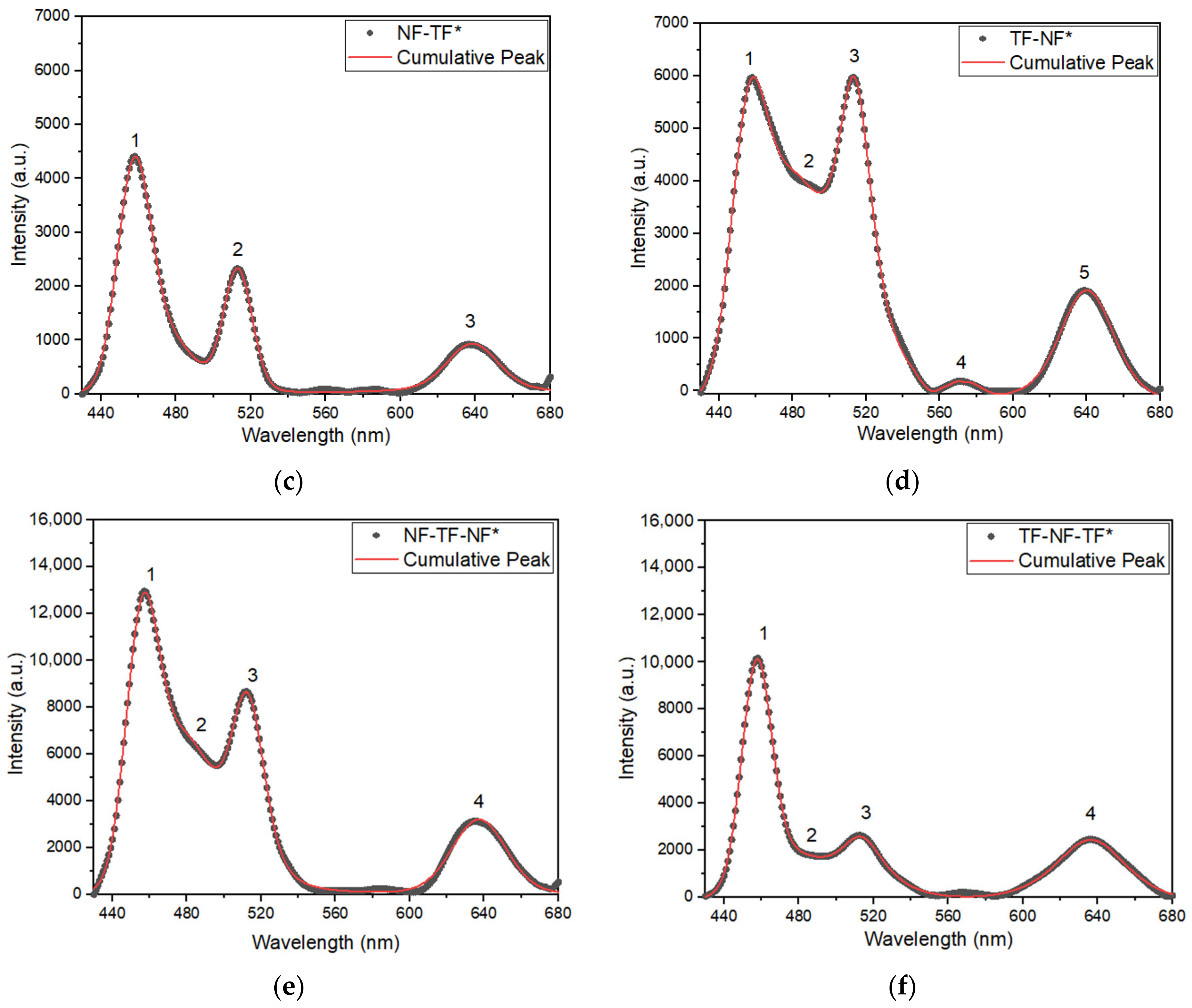
| Element (Line Type) | Atomic% | |
|---|---|---|
| NF | NF-TF-NF* | |
| C K | 8.10 | 9.04 |
| O K | 47.13 | 40.18 |
| Si K | 27.71 | 28.63 |
| Tm L | 0.99 | 1.67 |
| Hf M | 16.07 | 20.48 |
| Sample | No. of Peak | Peak Centered (nm) | Area (a.u.) | Gaussian FWHM, wG (nm) | Lorentzian FWHM, wL (nm) | FWHM (nm) |
|---|---|---|---|---|---|---|
| NF | 1 | 458.51 ± 0.07 | 27,398 ± 1698 | 19.13 ± 1.16 | 4.12 ± 2.13 | 21.4 |
| 2 | 513.08 ± 0.43 | 13,052 ± 1140 | 18.56 ± 0.75 | 0 | 18.6 | |
| 3 | 532.95 ± 2.64 | 2528 ± 2835 | 20.68 ± 18.82 | 0 | 20.7 | |
| 4 | 580.41 ± 1.87 | 1132 ± 377 | 30.13 ± 5.49 | 0 | 30.1 | |
| 5 | 637.36 ± 0.46 | 10,401 ± 2629 | 9.74 ± 13.38 | 26.54 ± 10.68 | 29.9 | |
| TF | 1 | 458.74 ± 1.66 | 17,969 ± 7419 | 25.99 ± 2.14 | 0 | 26.0 |
| 2 | 485.11 ± 3.07 | 5888 ± 2341 | 30.91 ± 41.94 | 2.77 ± 1.68 | 32.4 | |
| 3 | 511.22 ± 1.46 | 18,428 ± 3535 | 25.02 ± 2.97 | 3.25 ± 3.29 | 26.8 | |
| 4 | 580.05 ± 2.05 | 3139 ± 1140 | 48.32 ± 5.21 | 0 | 48.3 | |
| 5 | 637.53 ± 0.46 | 4854 ± 4224 | 27.25 ± 14.24 | 7.23 ± 33.02 | 31.3 | |
| NF-TF* | 1 | 458.87 ± 0.20 | 104,418 ± 3352 | 21.91 ± 0.97 | 0.68 ± 1.39 | 22.3 |
| 2 | 511.82 ± 0.12 | 53,223 ± 2962 | 16.31 ± 1.42 | 5.67 ± 2.15 | 19.5 | |
| 3 | 480.16 ± 1.13 | 13,518 ± 2126 | 18.26 ± 1.98 | 25.69 ± 5.07 | 35.6 | |
| 4 | 637.91 ± 0.36 | 38,169 ± 4925 | 0 | 12.85 ± 7.54 | 12.9 | |
| TF-NF* | 1 | 455.65 ± 0.10 | 91,357 ± 7848 | 21.69 ± 0.57 | 0 | 21.7 |
| 2 | 477.17 ± 1.06 | 176,679 ± 11,901 | 43.43 ± 2.04 | 0 | 43.4 | |
| 3 | 513.86 ± 0.08 | 221,347 ± 5633 | 6.44 ± 1.72 | 23.24 ± 1.07 | 25.0 | |
| 4 | 575.29 ± 0.81 | 4302 ± 2304 | 17.17 ± 8.34 | 0.13 ± 15.30 | 17.2 | |
| 5 | 640.07 ± 0.13 | 101,948 ± 8665 | 25.73 ± 2.47 | 16.86 ± 4.15 | 35.9 | |
| NF-TF-NF* | 1 | 455.88 ± 0.15 | 234,669 ± 15,351 | 20.95 ± 0.38 | 0 | 20.9 |
| 2 | 478.79 ± 0.92 | 241,217 ± 19,747 | 36.35 ± 2.52 | 0 | 36.3 | |
| 3 | 512.73 ± 0.15 | 229,082 ± 6521 | 17.04 ± 0.78 | 9.52 ± 1.02 | 22.7 | |
| 4 | 637.27 ± 0.15 | 118,194 ± 6626 | 33.35 ± 1.92 | 2.02 ± 3.44 | 34.4 | |
| TF-NF-TF* | 1 | 457.34 ± -- | 209,130 ± -- | 17.843 ± -- | 2.29 ± -- | 19.1 |
| 2 | 475.96 ± 3.50 | 41,046 ± -- | 28.86 ± 20.02 | 0 | 28.9 | |
| 3 | 510.91 ± 1.36 | 157,012 ± -- | 5.0485 ± -- | 34.67 ± -- | 35.4 | |
| 4 | 637.43 ± 2.59 | 164,533 ± 35,765 | 31.57 ± 63.36 | 24.25 ± 122.79 | 46.5 |
Publisher’s Note: MDPI stays neutral with regard to jurisdictional claims in published maps and institutional affiliations. |
© 2022 by the authors. Licensee MDPI, Basel, Switzerland. This article is an open access article distributed under the terms and conditions of the Creative Commons Attribution (CC BY) license (https://creativecommons.org/licenses/by/4.0/).
Share and Cite
Zulfikri, N.I.Z.; Ibrahim, A.-B.M.A.; Mustaffa, N.A.; Mohamad Yunus, R.; Ahmad Kamil, S. Enhancing Photoluminescence Intensity and Spectral Bandwidth of Hybrid Nanofiber/Thin-Film Multilayer Tm3+-Doped SiO2–HfO2. Nanomaterials 2022, 12, 3739. https://doi.org/10.3390/nano12213739
Zulfikri NIZ, Ibrahim A-BMA, Mustaffa NA, Mohamad Yunus R, Ahmad Kamil S. Enhancing Photoluminescence Intensity and Spectral Bandwidth of Hybrid Nanofiber/Thin-Film Multilayer Tm3+-Doped SiO2–HfO2. Nanomaterials. 2022; 12(21):3739. https://doi.org/10.3390/nano12213739
Chicago/Turabian StyleZulfikri, Nurul Izzati Zafirah, Abdel-Baset M. A. Ibrahim, Nur Amalina Mustaffa, Rozan Mohamad Yunus, and Suraya Ahmad Kamil. 2022. "Enhancing Photoluminescence Intensity and Spectral Bandwidth of Hybrid Nanofiber/Thin-Film Multilayer Tm3+-Doped SiO2–HfO2" Nanomaterials 12, no. 21: 3739. https://doi.org/10.3390/nano12213739
APA StyleZulfikri, N. I. Z., Ibrahim, A.-B. M. A., Mustaffa, N. A., Mohamad Yunus, R., & Ahmad Kamil, S. (2022). Enhancing Photoluminescence Intensity and Spectral Bandwidth of Hybrid Nanofiber/Thin-Film Multilayer Tm3+-Doped SiO2–HfO2. Nanomaterials, 12(21), 3739. https://doi.org/10.3390/nano12213739






